Jeff Meyer's report to his mother Elsa Trefzger Meyer.
2003
Scroll down to read the entire account.
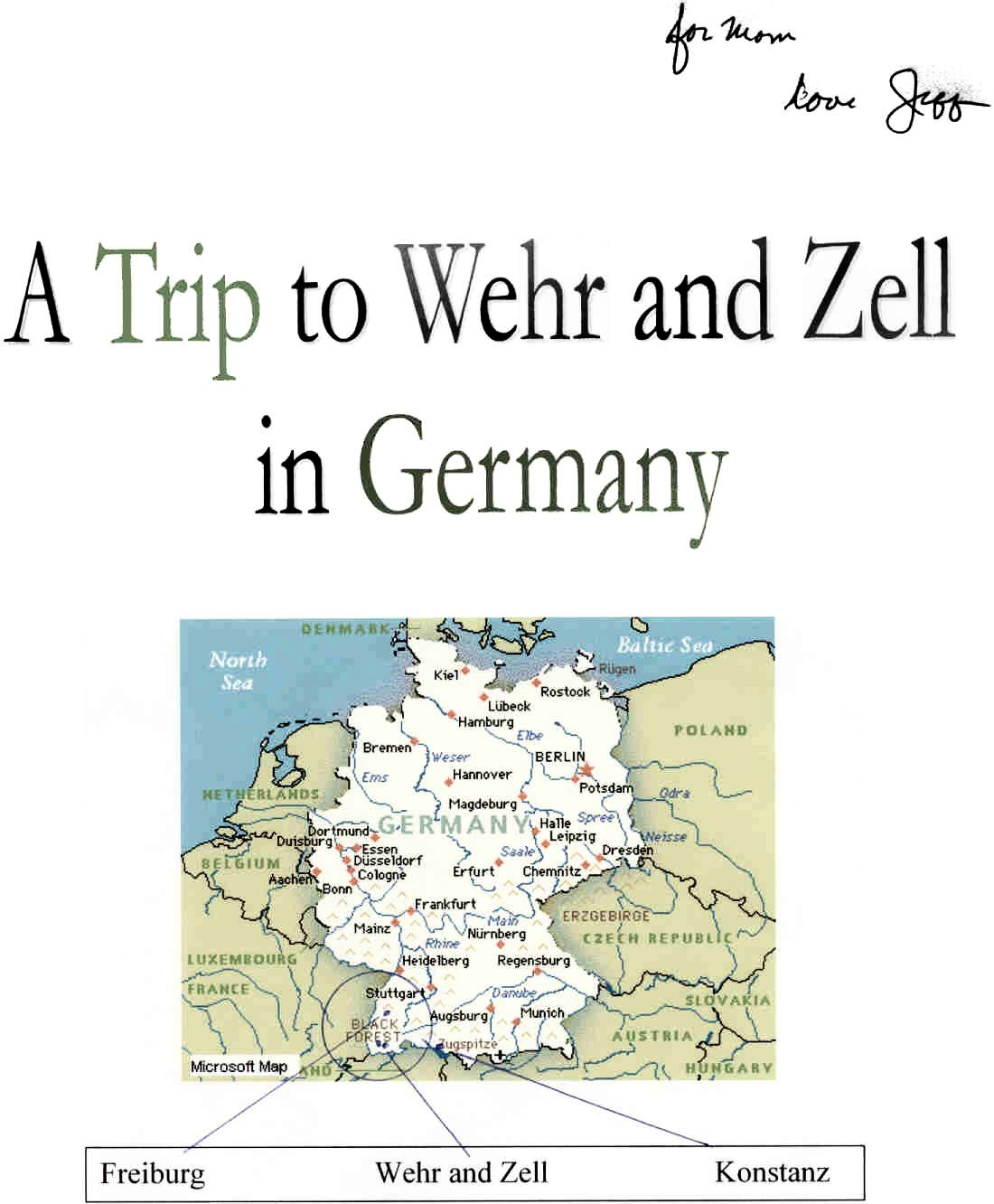
"Back to the Roots" A Trip to Wehr and Zell
Although I spent only two days in Wehr and Zell, it was the real purpose
of my week-long trip to Germany--to see the small towns where the
Trefzger and Berger families originated, over 150 years ago. I am not
completely sure why I wanted to do this. I think that I wanted to find
out, if by going there I could feel some connection with the past, re-
experience it in some way. I thought that I might see something in a
face that was reminiscent of a Berger or Trefzger that I knew, and
actually feel some sense of what had been, a long time ago. None of this
happened, but I am still glad that I went, if only to get these ancestral
shadows out of my mind.
On an Waterbed in Wehr
But back to my trip to Wehr and Zell. I got from Freiburg to Wehr by
train and bus. The last 10 kilometers by bus was a pleasant drive
between Schopfheim where I got off the train, and Wehr. The country
reminded me of parts of the Blue Ridge Parkway. Wehr is in a valley at
the southern end of the Black Forest Mountains, rolling fields and lots of
woods, pine and hardwoods deep into their late fall colors. I think the
area reminded me of the Blue Ridge Parkway also because there is no
advertising to deface the countryside.
I had found nothing about Webr in my travel guide, so while in Freiburg
I looked through some other travel guides, in a bookstore. Only one had
mentioned it, with a single notice of a hotel called the Klosterhof. For
this I was grateful, because when I arrived at 3:00pm the tourist
information center had already closed. So I walked about a half mile to
the northern edge of town, found the place but it had a sign on the door
"ruhiger tag" which meant that they were closed for a "rest" day. So
reluctantly, I turned around and headed back to the town center, by this
time having a bad case of overfull bladder. Where do you go to pee in a
small town? Finally, in fair agony, I spotted a bar that was open, bolted
through the door and asked the barman "where's the toilet?" He looked
at me grumpily and motioned to a door in back. Happiness, as Snoopy
might say, is finding a john when you need one!
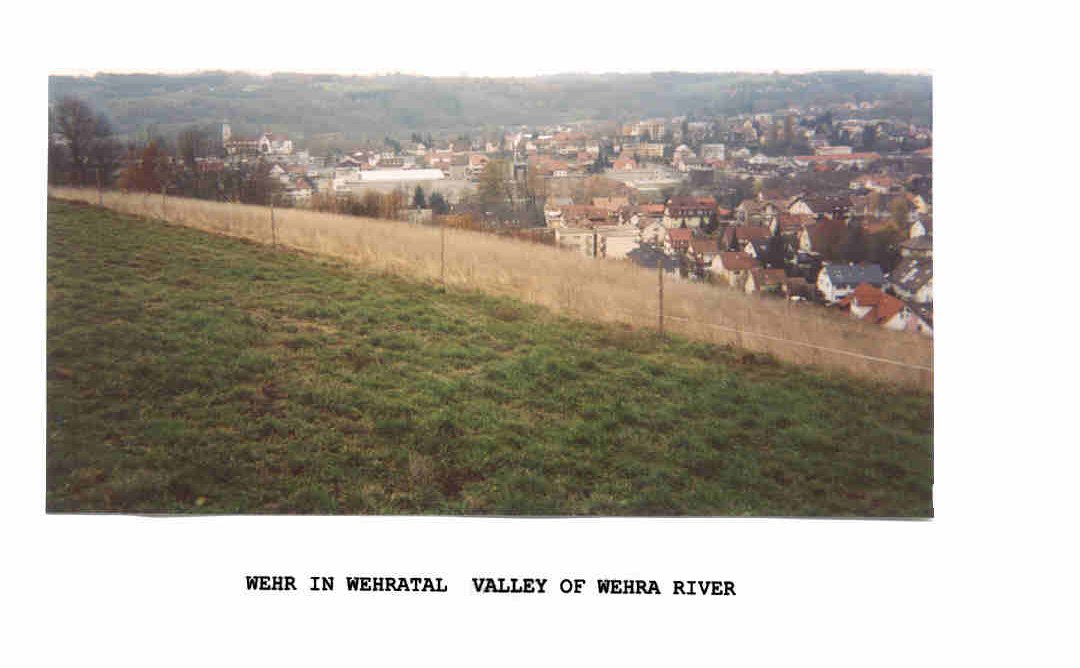
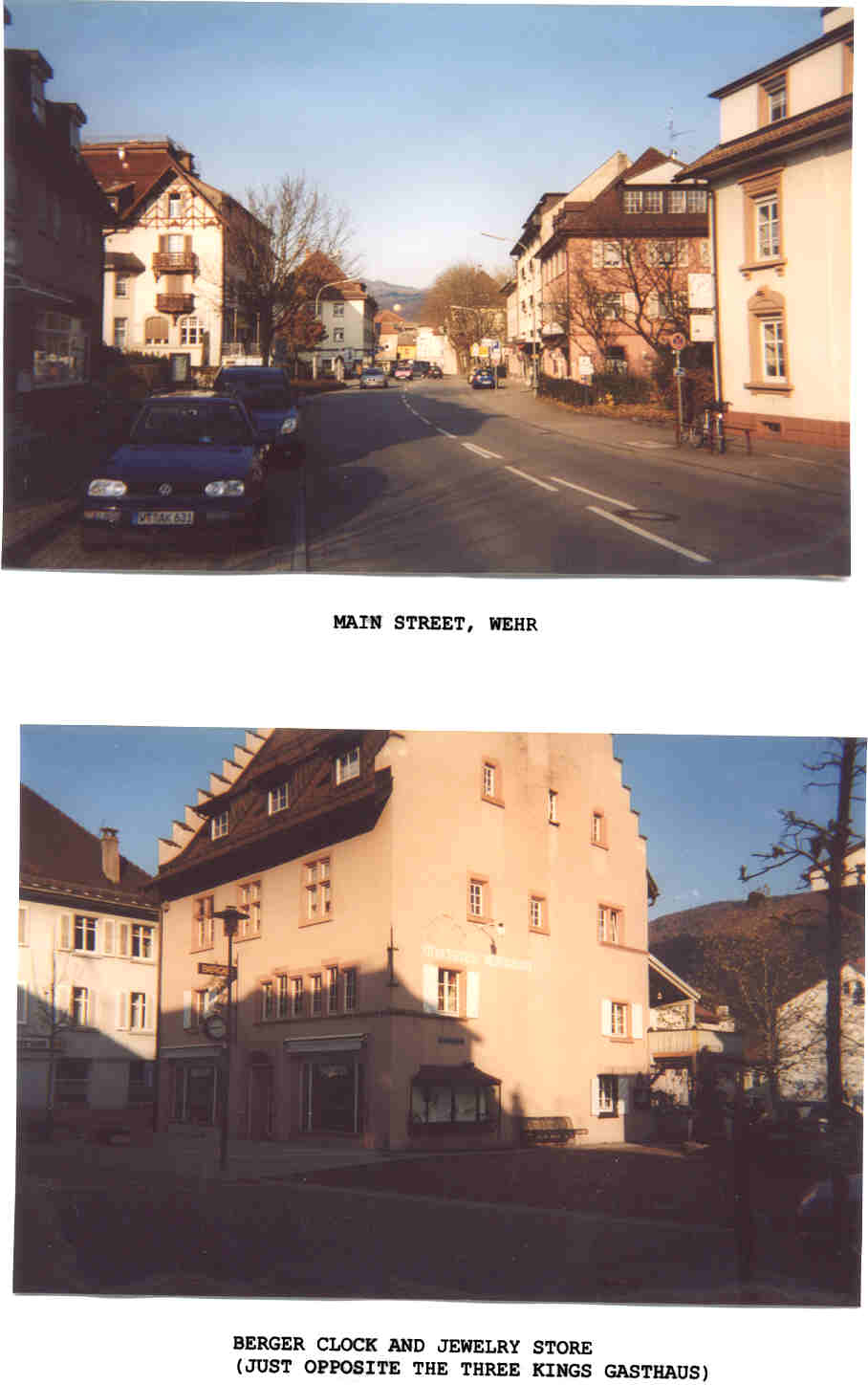
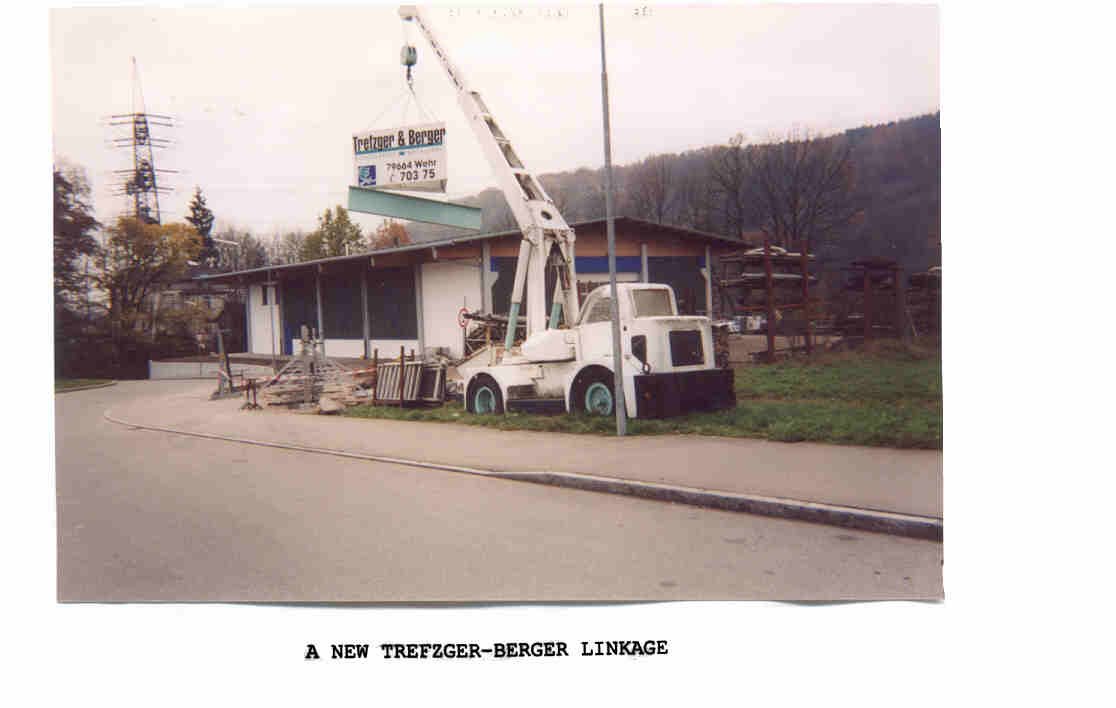
When I came out I felt obliged to buy a beer, and I explained to him in
my seriously limited German why I had come to Wehr. "Ja, Ja," he said
"we have lots of Trefzgers and Bergers," obviously unimpressed with
my quest. I checked out the local telephone listIngs and found 41
Trefzgers in Wehr and 24 Bergers. For Zell, which is smaller, there
were 24 Bergers and 8 Trefzgers. On the wall of his establishment was
an enlargement of a photo about 100 years ago. I would have
to say that, compared to the rather tidy and prosperous town I had
found today, this old Wehr looked run down, with shambly buildings
and muddy streets. When I asked him if he knew a place I might stay
for the night, he said "keine ahnung" (no idea). Then another customer
arrived who was friendly and tried to help, but his local dialect was so
thick that I couldn't understand what he was talking about. I
remembered Grosspapa at Christmas time singing first "Oh
Tenenbaum," then singing it all over again in the Wehr area dialect. It
sounded something like "Oh Tanabooem. " So I left the tavern, and not
one block south saw a gasthaus/tavern on the corner called Three
Kings. Jerk. How could the barman not known about this place? This
one had customers and as I walked in everybody looked at me. Who is
this? I asked the bartender if they had a room available. He hesitated
but finally said that he thought they might have one, but I should please
come back after 6:00 pm.
So I wandered around a while and soon the obligatory beer was having
its effect, so I went into Michelangelo's Italian Restaurant to use the
facilities and stayed for an early dinner. I decided to switch to a small
glass of red wine this time. Who knows how long I'd be tramping
around after dinner? In my ramblings I had seen three or four shop signs
with Trefzger or Berger on them. I also had to readjust my concept of
Wehr. I suppose for me Wehr was supposed to be a little town in a
remote area that history had passed by. I remember Grosspapa talking a
lot about Wehr, so it had taken on a kind of mythic quality through my
remembering these grandfatherly accounts so long ago. Well, the news
is that Wehr has changed just like the rest of the world. All the high tech
shops are here, modular phones, computers, internet, video games and
all the rest. No old fellows wandering around in lederhosen, nor women
in Bavarian peasant style outfits. Chic boutiques, Italian and French
designer clothes, kids with piercings and metal rings, rock music, and
quite a few ethnic groups that I'm sure my great grandparents had never
seen: Turkish, Greek, south Asians, east Asians, and my hosts at
Michelanglo' s, from south of the Alps. One photography shop on Main
Street, along with the usual wedding and baby photos on the front
windows, had a photo of an entirely naked woman! Wehr is ahead of
Charlotte in that department.
After finishing my spagetti bolognese, heavy on pasta, light on sauce, I
returned to the Three Kings. They said yes, they could let me have a
room, if I could sleep on a waterbed. 27.50 Euros per night, breakfast
included. At this point, I was desperate, so I said I would be glad to try
the waterbed. The bar tender asked a blond woman to take me to my
room. She spoke perfect English (and so did he, I found out the next
day), from Texas. She pointed to her last Texas license plate, nailed to
the wall behind the bar. Next to it was a Maine license plate. That's my
brother's, she said, without any further explanation. The room was
huge, about 15 by 25 feet, though a bit threadbare. But at least I had a
place to stay. The wind was really roaring outside, coming right through
the cracks in the old windows. I worried that it might blow the window
boxes and their plastic flowers down onto the sidewalk below. I was on
the third floor, the water closet at the end of the corridor, the shower
downstairs on the second floor. "You've got 37 channels on that TV,"
said the blond woman, as though I had just won the lottery. After she
left, I pressed the remote and it fell apart. I tried the button on the TV
set. It didn't work. Oh well, who needs TV? I could look out my
window, and above the stores across the street, above the mountains was
a full moon. I wrote my journal entry that night wobbling on my water
cushion. Later that night I did get some "entertainment." Someone came
in about 3:00 and soon two people were yelling and arguing at the tops
of their voices. But I was so tired that it just became background noise.
I sailed off in my waterbed to the land of nod.
Next morning I went down to the bar and the bar tender asked if I
wanted breakfast. Yes, I said (of course, I thought, it was part of the
deal). I explained what I was doing in Wehr. He, too, was unimpressed,
assuring me that Wehr had lots of Trefzgers and Bergers. There's a new
metal working company co-owned by a Trefzger and Berger, he said,
but they are not related. Old Trefzger, the co-owner's father, might be
in later. (He never came.) The blond appeared, in a funk. "I'm beat,"
she said to the bar tender, who I must be her husband. "I've
put on a ton of make up and it won't cover the black under my eyes." I
decided it was best not to inquire about last night's argument.
From the Three Kings I walked down a street that crossed the Wehra
river under a covered wooden bridge, and followed a path up the hillside
to the ruins of a fortress. First built in 1099 and variously rebuilt, the
last time in 1790, making it a fitting and secure place for the nobility of
Baden to live in when they visited the area. In other words, it housed the
nobles our ancestors left Wehr to get away from. Nothing was done
between 1790 and almost 1990 and then the Black Forest Verein (some
kind of heritage preservation group?) built a wooden viewing platform
above it. I climbed up to it and from there I could look across to the
town and saw the parish church of St. Martin, set on a hill and
architecturally dominating Wehr. I headed there next.
I found the church very busy preparing for the feast of St. Martin, which
was the next day, Sunday. Inside I discovered that the church was
restored to its baroque splendor, with three tromp l'oeil paintings on the
ceiling, leading you to think you are looking through a hole into the sky
where you can see Mary and the saints, and lots of cherubs. There was a
group of children up in the sanctuary and a director of some sort was
trying to explain their roles, I assumed, on the following day. They were
gabbing among themselves, and the director frequently banged his book
on the communion railing to get their attention.
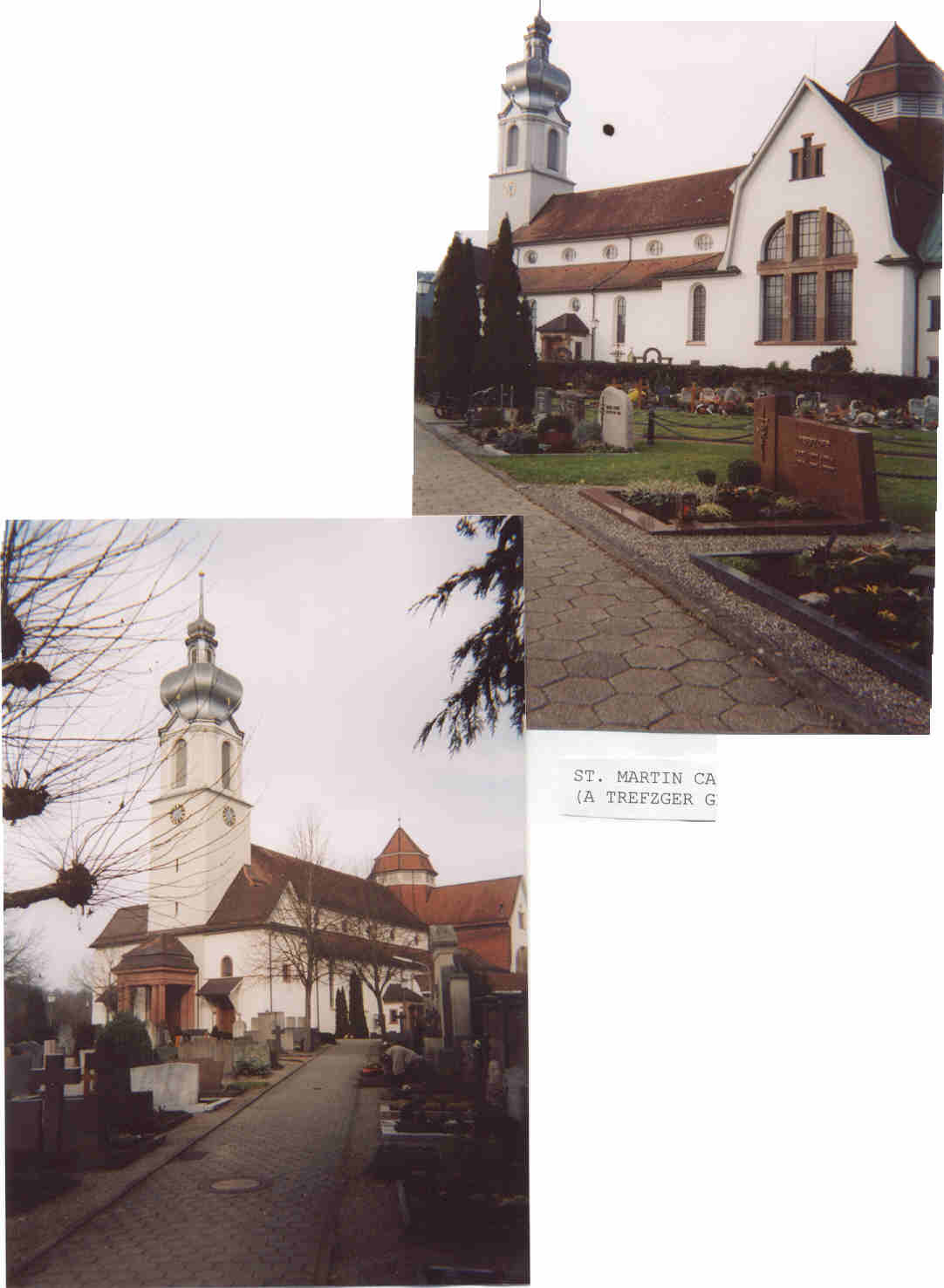
Outside, I explored the graveyards, which pretty much surrounded the
church. Graveyards are extremely important in German Catholicism, I
discovered, far more so than in the U.S. Almost all the old gravestones
have been removed and replaced by new opulent ensembles of polished
granite or marble. They are beautifully landscaped with bushes, vines
and flowers, and carefully tended. Most of this has been done in the last
15 years or so, as Germany has become more affluent. I'm guessing, but
these grave ensembles must cost thousands of dollars to erect. So
different than in the U.S., the land of fading plastic flowers, renewed, if
the departed are lucky, once every few years. As I walked around I
counted some 8-10 people working on their family graves. One of these
was a woman tending a Trefzger grave (of which there were 10 to 15 by
my rough count). I asked her if she was a Trefzger. She said yes, on my
mother's side. I introduced myself as a Trefzger, which led to a brief
conversation about our families, brief because my German is so limited
and she spoke no English. But I could tell that she, too, was not
particularly impressed that I was a Trefzger - there are just so many of
them around. Maybe it would be like a German coming to the U.S.,
meeting a Mr. Schmidt and then saying, "Oh, I'm a Schmidt too." Not a
real conversation starter.
What I did find moving was a memorial to men from St. Martin's parish
who had died in World War 1 and World War 11. There were hundreds
of names listed.
I found, dead or missing in World War 1. six Trefzgers:
Alois
August
Theodor
Emil
Franz
Julius
Franz Trefzger. ...It was the name that got to me.
There were two Bergers:
Adolph
Johann Fridolin
Again, it was the name. John Berger.
In World War 11 there were nine Trefzgers:
Ernst
Gustav
Hermann (2)
Karl Friedrich
Sigfried
Otto
Walter
Wolfgang
And five Bergers:
Ernst
Franz Joseph
Max
otto
Wolfgang
I thought of how familiar, somehow, these names sounded, and how
different things could have been had our ancestors, with the same names,
not left for America, and how ordinary people get caught up in politics,
the military and war.
Threatened by Royalty in Zell
It was now late morning and time to leave for Zell im Wiesental.
Whenever I mentioned going to Zell, Germans would always ask "im
Wiesental?" So there must be one or more towns called Zell in
Germany. I returned to Schopfheim and took the train three more stops
to the last stop on the line, which was Zell. Zell is more remote and
picturesque than Wehr, far up the Wiesental valley, nestled in a place
where the river valley becomes narrow. The town is built on the
hillsides and the higher mountains tower above it. Still, if I was
expecting the place to have escaped the modern world, I was soon
disabused of that notion. The fIrst person I saw standing on the platform
as my train pulled in was what Julia would call "a goth" - modern, not
the old kind of goth. He was tall and thin, entirely clothed in black, his
leather covered with silver studs, bosses and chains. His head was
shaved except for a long pony tail. Like Wehr, Zell has changed with
time.
The town was somnolent on a Saturday afternoon with few stores
at all and fewer still open. There was a small fountain erected in honor
of Carl Maria von Weber and a street named after him, so I supposed
that he is Zell's most famous son. I checked an biographical dictionary
of musicians, and it did not list him as being born there. But he was the
cousin of Constanze, Mozart's wife, who was born there. That should
be fame enough. I walked up the hill to St. Fridolin Catholic Church.
Opposite it was a woodsy area with a long pond. I noticed a swan at the
upper end. As soon as he saw me he came roaring down the pond,
wings wildly flaping and hooting, coming to a screeching halt where the
pond ended just in front of me. I reached into my pack, broke off a
piece of bread and threw it to him. He glanced at it contemptuously and
continued to glare at me. I could see he was motived by royal
arrogance, not hunger and decided to leave him to his kingdom. I
walked across the street to the church.
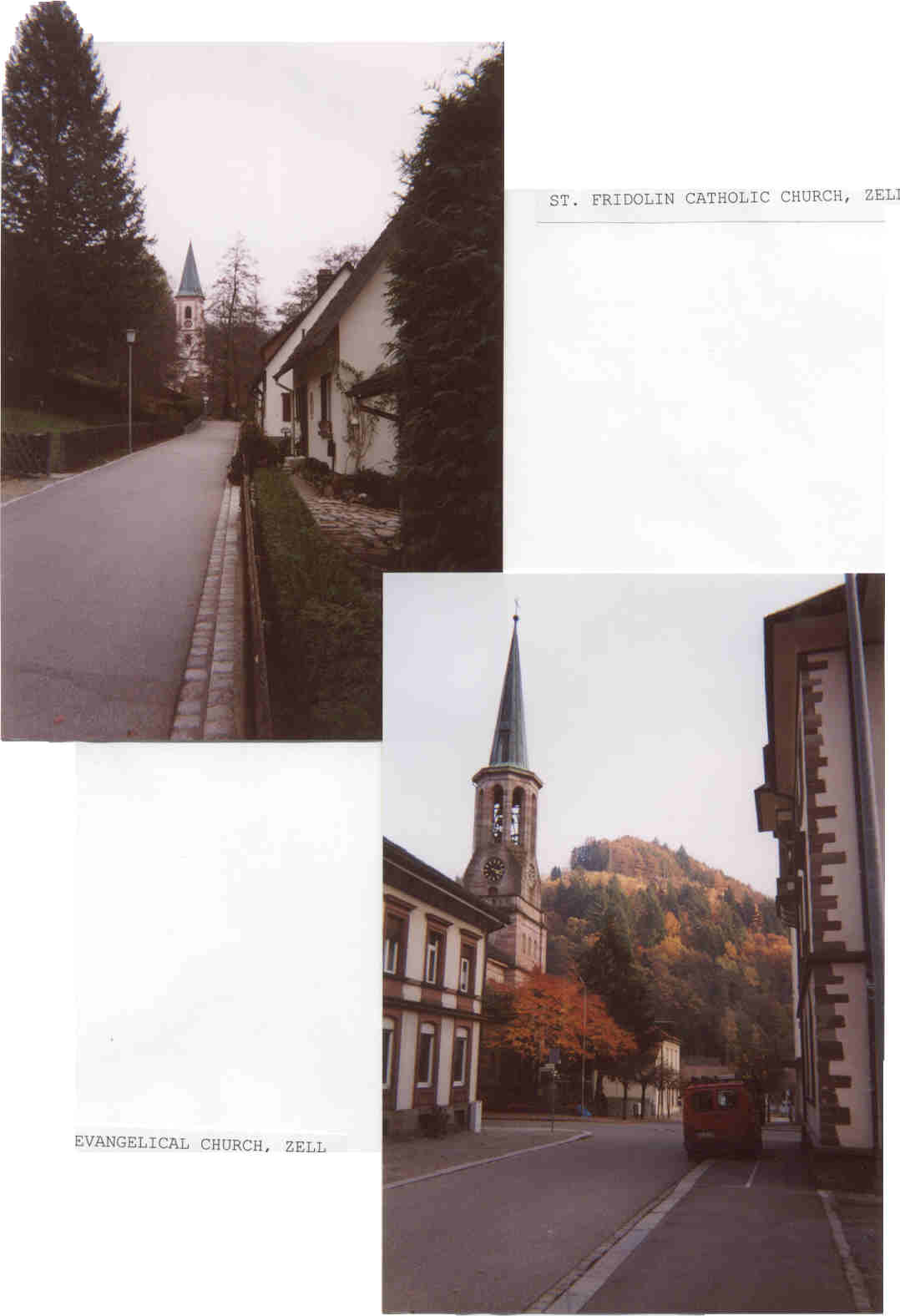
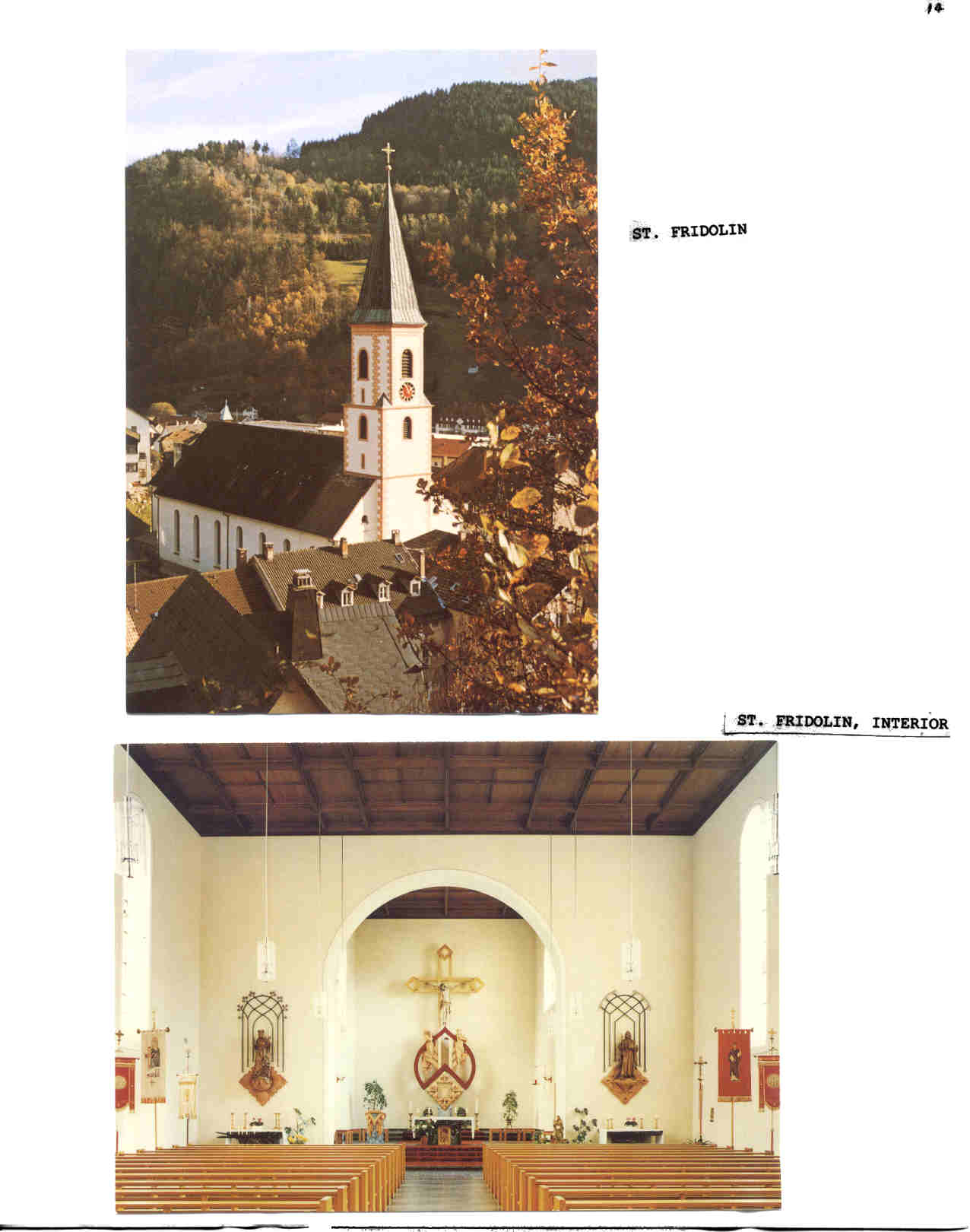
St. Fridolin was built in 1826 and would have been there for a few
decades when my great great grandfather Meinrad was getting ready to
leave Zell. I thought of the strong faith of the Bergers and Trefzgers that
must have been nourished in these two churches, St. Martins in Wehr
and St. Fridolin in Zell. Alfred, Richard, Adela, Herbert were the most
overtly religious, others perhaps less obviously so, but the Catholic
Church exerted a huge influence over all their lives and the lives of their
children. This strong religious influence in the families began in these
remote valleys in Baden over 150 years ago, nourished by these
churches. The inside of St. Fridolin was also in good condition, recently
refurbished and renovated but in a very different way from St. Martin.
The interior is now very contemporary in feeling, stripped down, simple,
austere. Clearly the much of the exuberance of design and the kitsch of
Catholic piety , statues, altars, decoration, was eliminated here, while it
was preserved at St. Martin.
Seeing no graveyard, I rang the rectory doorbell, and was answered
by the priest and housekeeper together. I introduced myself, told them I
was a Berger and my ancestors had come from here 150 years ago. A
non-commital nod to that. Again, too many Bergers I suppose, but the
pastor was quite friendly. We had only a short conversation because he
spoke no English. I asked directions to the parish graveyard, which in
this case was not contiguous with the church. He directed me to a steep
hillside site up the road, where I found the same well kept and
sumptuous gravesites, and lots of Bergers, but no Trefzgers. St. Fridolin
had only a generalized monument to the dead of the two world wars, but
I saw many familiar inscribed on the tombstones: Johann Berger, Joseph
Berger, Anna Berger, Teresa Berger, Amanda and Alfred Berger were
all there.
Our ancestors left Germany shortly after the failed revolutions of
1848, when there were uprisings of the common people allover Europe
trying to throw off the yoke of the nobility and challenging the divine
right of Kings. Dire retribution followed, and perhaps our ancestors left
to avoid the worst of its consequences. They were in good, or at least
famous, company. That same year Karl Marx was driven out of Basel,
says my travel guide, just a few miles to the southwest of these remote
valleys, and wound up in London writing the Communist Manifesto in
the British Museum. I am not sure if the Bergers and Trefzgers were
driven more by political or economic motives, maybe a combination of
the two. But leave they did, and as a result, our Johanns, AIfreds,
Friedrichs, Annas, Theresas, Josephs, and all the rest found a very
different future than those with the same names that lie in these
graveyards of St. Martin and St. Fridolin
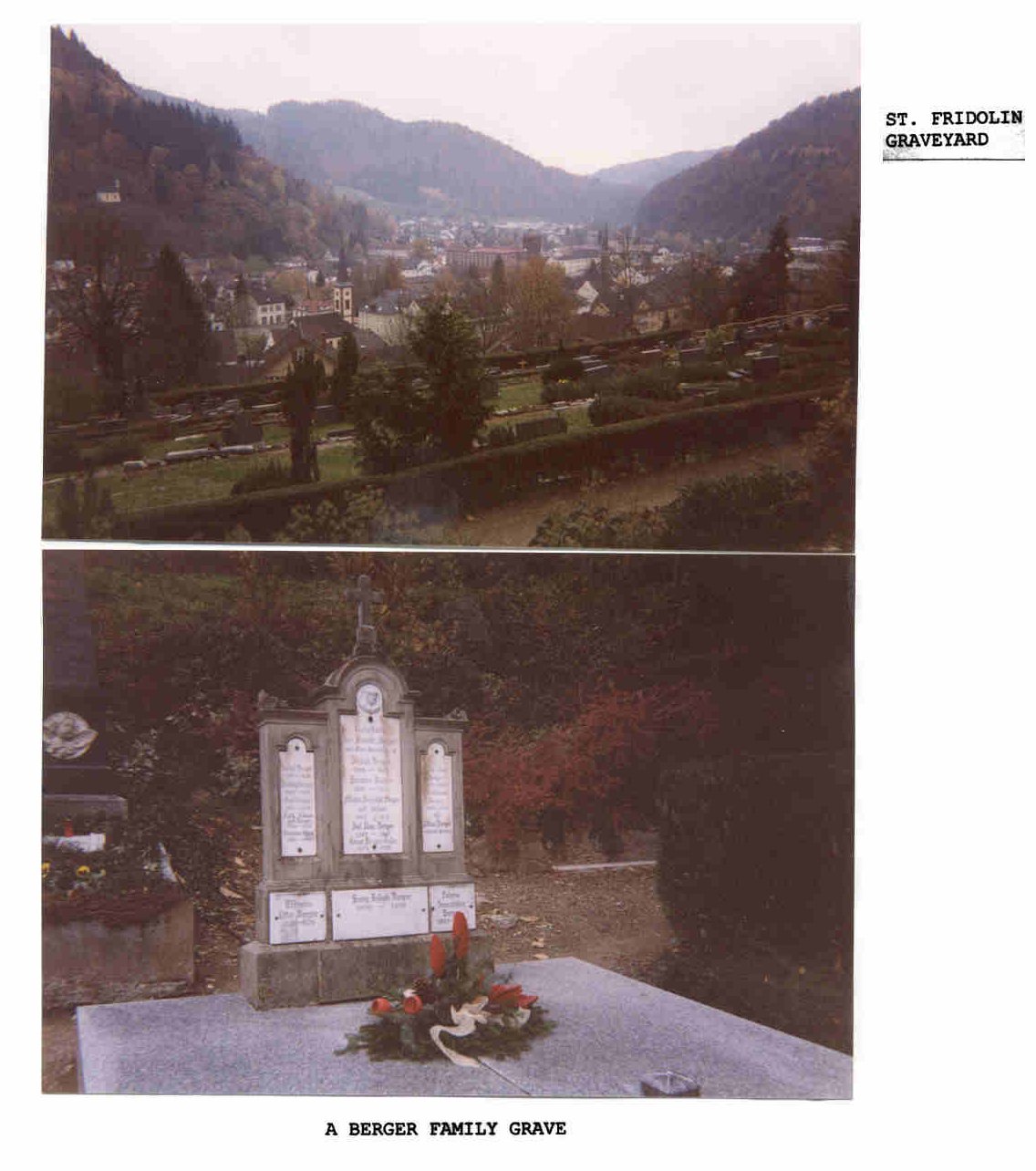
Return to: 1st_Page Trefzger Roots Berger Roots







